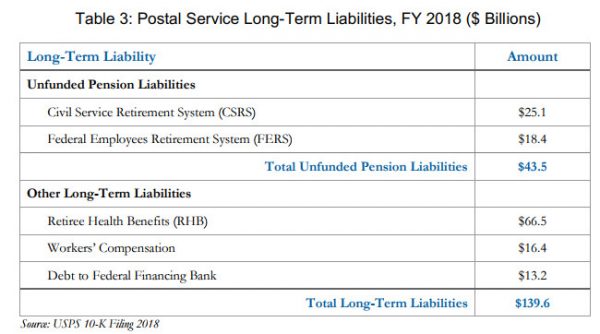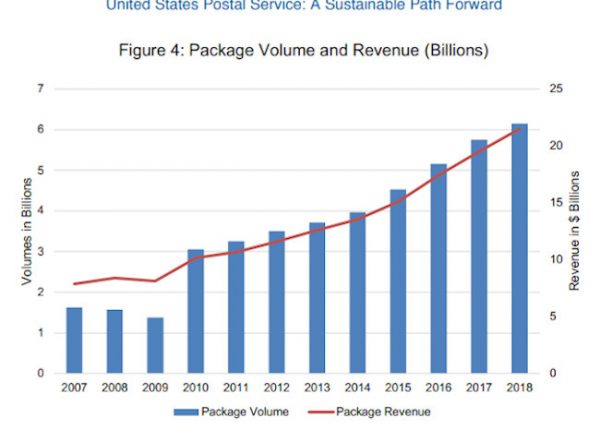By Sheryl Hamlin
On December 4, 2018, a task force organized by the US Department of the Treasury released a report entitled: ”United States Postal Service: A Sustainable Path Forward Report from the Task Force on the United States Postal System” Download the report here.
USPS Major Employer
The report states: In the third quarter of 2018, the USPS employed around 630,000 employees. The states with the highest USPS employment are California, New York, and Texas.
To put the employee count in perspective, Walmart has 2.2 million employees and is the largest employer in the United States. Amazon has 630,000 employees worldwide. Yum! Brands is the number two with 523,000 employees. Source.
Unique Labor Structure
From the report: Career postal employees are represented by nine unions and two management associations. Postal workers, like most federal civil service employees, participate in the Civil Service Retirement System (CSRS) or the Federal Employees Retirement System (FERS), as well as in the Federal Employees Health Benefits Program (FEHB), and are covered by the Federal Employees Compensation Act for workers’ compensation claims. However, unlike other federal workers, the PRA authorizes collective bargaining on compensation, some benefits, and conditions of employment, and postal unions are therefore able to negotiate compensation, benefits, and working conditions. Given their federal employee status and the role that the USPS plays in the economy, USPS employees maintain a unique collective bargaining position. They can bargain for wages and benefits as private sector unions do, without the same level of risk that their company will go out of business.
On a positive note, the report says: While the USPS pension liabilities are better funded than those of the rest of the federal government, they would benefit from further reform…


Demographics and Technology Affecting Business Model
While letter writing, bill payments, printed newspapers and catalogues have been declining with the advent of email and electronic bill paying, the USPS has benefitted from its increased package delivery service. Note that the report does not mention how USPS has upgraded its tracking capability to equal or surpass that of UPS and Fedex. However, the package delivery does not offset the huge loss in the letter delivery.


Path to Sustainability
The substance of the report can be deduced from this paragraph: For the USPS to become a sustainable entity, the new business model must permit the USPS to actively contain and reduce its costs as its mail volume declines and as competitive pressures in the package markets dictate. The Task Force believes that the USPS must operate in a more cost-efficient manner by exercising discretion to lower service standards and to increase the use of third parties through additional work sharing and the use of third party processing and logistics providers. In addition, as postal employees are part of the U.S. federal civil service, their wages and benefits should be aligned to comparable U.S. federal employee groups, including aligning their ability to collectively bargain for wages and benefits with other federal employees.
In other words, the task force envisions the USPS becoming more like a business by allowing it to set is own delivery schedules, product pricing, and partnerships.
Questions to be asked
Are businesses who use the USPS ready to pay increased prices for “business mailing services” which is one of the recommendations.
Will “partnerships” in mail services become a path to privatization?
How does the guaranteed service to rural communities survive in a “sustainable” environment?
The task force noted that international service does not favor the USPS and there is a plan to extricate the United States from international postal tariffing, but the report did not elaborate on those savings. A report from Forbes gives an idea of the imbalances in the international postal “deals”. Read that report here.
Are there other quasi-business activities in the United States Government which exist without some form of subsidy?
Rebuttal from NALC (National Association of Letter Carriers)
To read the rebuttal from the NALC click here
From NALC:
The principle recommendations would dramatically raise mailing costs for “commercial mailers” and shippers, slash the frequency and quality of delivery, and gut the standard of living of postal employees by outsourcing their jobs, stripping them of collective bargaining rights and reducing their retirement and workers’ compensation benefits. These recommendations would weaken, not strengthen the Postal Service – and threaten the most efficient and affordable universal postal system in the world.
Election Issue
This report has not been widely publicized. With a huge presence and long history (since the Civil War), the USPS and its “path to sustainability” could become election material.
For more on the author, click sherylhamlin dot com
Get Citizensjournal.us Headlines free SUBSCRIPTION. Keep us publishing – DONATE




2020 USPS announces increase in package delivery rates….
https://about.usps.com/newsroom/national-releases/2019/1009-usps-announces-new-prices-for-2020.htm